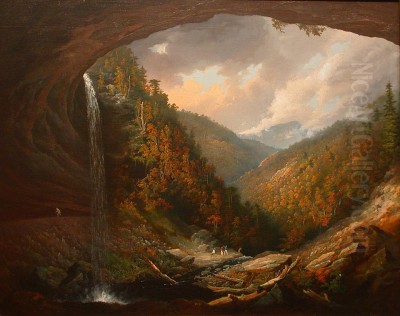
William Guy Wall (1792-1864) stands as a significant, if sometimes under-appreciated, figure in the annals of American art history. An Irish-born painter who immigrated to the United States in the early 19th century, Wall became one of the earliest artists to capture the burgeoning nation's distinctive landscapes, particularly the majestic scenery of the Hudson River Valley. His meticulous watercolor views, later popularized through engravings, played a pivotal role in shaping the visual identity of America and laid crucial groundwork for the artists of the Hudson River School, the country's first native school of landscape painting.
Wall's artistic journey, straddling two continents and evolving through various artistic communities, offers a fascinating glimpse into the transatlantic cultural exchanges of the era and the nascent development of a uniquely American artistic vision. His work, characterized by a direct, topographical approach blended with a subtle appreciation for atmospheric effects, provided a vital link between European landscape traditions and the new artistic expressions taking root in the New World.
Early Life and Emigration to America
Born in Dublin, Ireland, in 1792, William Guy Wall's formative years unfolded against a backdrop of significant political and social change in his homeland. While details of his early artistic training in Ireland remain somewhat scarce, it is evident that he acquired a proficient skill in watercolor, a medium that was gaining considerable popularity in Britain and Ireland at the time, influenced by artists like Paul Sandby and later, Thomas Girtin and J.M.W. Turner.
The Ireland of Wall's youth was a place of both cultural vibrancy and considerable unrest. The Act of Union in 1801, which formally merged Ireland with Great Britain, had profound implications for Irish society and identity. Economic opportunities were often limited, and for ambitious young individuals, emigration presented a pathway to new possibilities. Like many of his compatriots, Wall looked across the Atlantic to the young, expanding United States.
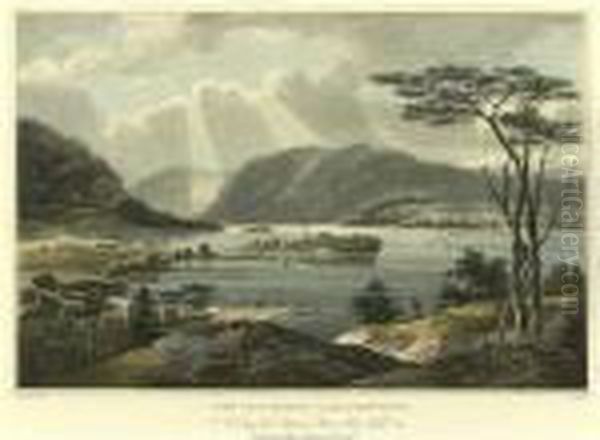
In 1812, a year marked by the outbreak of war between the United States and Great Britain, Wall made the momentous decision to emigrate. He arrived in New York City, a bustling port that was rapidly becoming the commercial and cultural hub of the nation. This move, undertaken at the age of twenty, placed him directly into an environment ripe for an artist with his particular talents.
Some accounts suggest his arrival might have been closer to 1818, but regardless of the exact year, his presence in New York during this period was timely. The nation was beginning to look inward, fostering a sense of national pride and an increasing appreciation for its own natural wonders. Wall, with his European training and fresh perspective, was well-positioned to contribute to this burgeoning cultural nationalism.
Artistic Development and Early Success in New York
Upon settling in New York, William Guy Wall quickly established himself as a skilled landscape painter. His primary medium was watercolor, which he handled with remarkable precision and sensitivity. He focused his attention on the scenic beauty of his adopted country, particularly the areas surrounding New York City and, most notably, the Hudson River Valley. This region, with its dramatic palisades, rolling hills, and picturesque waterways, was increasingly becoming a source of inspiration for artists and writers.
Wall's approach to landscape was largely topographical, aiming for a faithful representation of the scene before him. However, his work was not merely a dry recording of facts. He possessed a keen eye for atmospheric effects, the play of light and shadow, and the subtle gradations of color that defined the American landscape. His paintings often conveyed a sense of tranquility and ordered beauty, reflecting perhaps the prevailing Picturesque aesthetic inherited from British landscape traditions.
During his initial decade in New York, from roughly 1818 to 1828, Wall achieved considerable recognition. His watercolors were admired for their clarity, delicate execution, and the appealing subject matter they presented. He captured views of West Point, the Palisades, the Catskill Mountains, and various other sites along the Hudson, as well as scenes in New Jersey and Connecticut. These works resonated with a public eager to see and celebrate the landscapes of their own country.
His success was not confined to original watercolors. Wall's images gained much wider currency through the medium of printmaking, particularly aquatint engraving. This was a crucial development, as it allowed his views to be disseminated to a broader audience, fostering a wider appreciation for American scenery and, by extension, for Wall's artistry.
The Hudson River Portfolio: A Landmark Collaboration
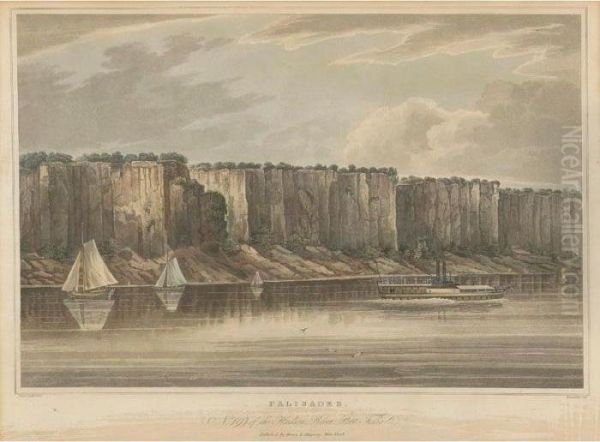
One of William Guy Wall's most enduring contributions to American art and culture was his involvement with the Hudson River Portfolio. Published between 1820 and 1825, this series of twenty hand-colored aquatint engravings is considered one of the finest examples of early American printmaking and a landmark in the visual representation of the Hudson River.
The original watercolors for the portfolio were created by Wall, showcasing his talent for capturing the diverse scenery of the river, from its bustling lower reaches near New York City to its more remote and wilder passages further north. These watercolors were then masterfully translated into aquatints by the English-born engraver John Hill (1770-1850), who had himself immigrated to the United States. Hill's skill in the complex aquatint process was essential in preserving the tonal subtleties and atmospheric qualities of Wall's original works.
The Hudson River Portfolio was published in parts by Henry J. Megarey in New York, and later by Carvill. It included iconic views such as Palisades, View near Fort Montgomery, Hadley's Falls, and View from Fishkill looking to West Point. Each print was accompanied by descriptive text, further enhancing its appeal and educational value. The portfolio was a commercial success and played a significant role in popularizing the Hudson River as a tourist destination and a subject of national pride.
This collaboration between Wall and Hill was instrumental. Wall provided the artistic vision and the initial renderings, while Hill's technical expertise brought these visions to a wider public. The portfolio not only cemented Wall's reputation but also set a high standard for American landscape depiction. It predated the major oil paintings of Thomas Cole, often considered the "father" of the Hudson River School, and thus represents a foundational moment in the development of that movement. The success of this venture also highlighted the importance of engravers like John Hill, and later his son John William Hill, in the dissemination of artistic images before the advent of photography.
Artistic Style and Techniques
William Guy Wall's artistic style is best characterized by its clarity, precision, and a somewhat reserved, topographical approach, particularly in his early American works. He was less inclined towards the overt romanticism or dramatic grandeur that would later define some Hudson River School painters like Thomas Cole or Frederic Edwin Church. Instead, Wall's landscapes often possess a calm, ordered beauty, emphasizing the harmonious relationship between humanity and nature, or simply the inherent charm of the scene itself.
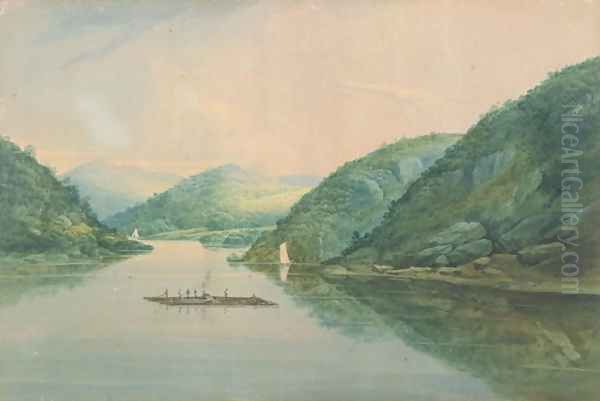
His mastery of the watercolor medium was central to his style. He employed traditional watercolor techniques, likely involving careful layering of washes to build up color and tone. His palette was typically bright and clear, reflecting the crisp light of the American atmosphere. He paid close attention to detail, rendering foliage, rock formations, and architectural elements with considerable accuracy. This meticulousness lent his works a sense of authenticity that appealed to his contemporary audience.
Wall often included small human figures in his landscapes. These figures were not usually the focal point but served to provide a sense of scale and to animate the scene, suggesting human interaction with the environment. They might be depicted boating, fishing, or simply admiring the view, reinforcing the idea of the landscape as accessible and enjoyable.
While often described as "unromanticized," Wall's work was not devoid of artistic sensibility. He had a good understanding of composition, often employing established picturesque conventions, such as framing devices (trees in the foreground) and leading lines (rivers or roads) to guide the viewer's eye into the scene. His depiction of water, with its reflections and transparencies, was particularly adept, showcasing his technical skill.
His work demonstrates an understanding of the achievements of late 18th and early 19th-century British watercolorists, adapting their techniques to the unique characteristics of the American landscape. He captured the vastness and the specific light quality of the New World, contributing to a visual vocabulary that other artists would build upon.
Notable Works and Their Significance
Beyond the collective impact of the Hudson River Portfolio, several individual works by William Guy Wall stand out and are frequently cited.
<em>New York from Weehawken</em>: This view, part of the Hudson River Portfolio, offers a panoramic vista of the burgeoning city of New York as seen from the New Jersey shore. It combines a detailed depiction of the urban skyline with the natural beauty of the Hudson River, symbolizing the close relationship between the city and its surrounding environment. Such views were popular, reflecting civic pride and the picturesque qualities of the harbor.
<em>Falls of the Passaic</em>: Depicting the scenic Passaic Falls in New Jersey, this subject was a popular one for artists of the period, drawn to its natural drama. Wall's rendition would have highlighted the geological features and the power of the water, appealing to the contemporary taste for sublime, yet accessible, natural wonders.
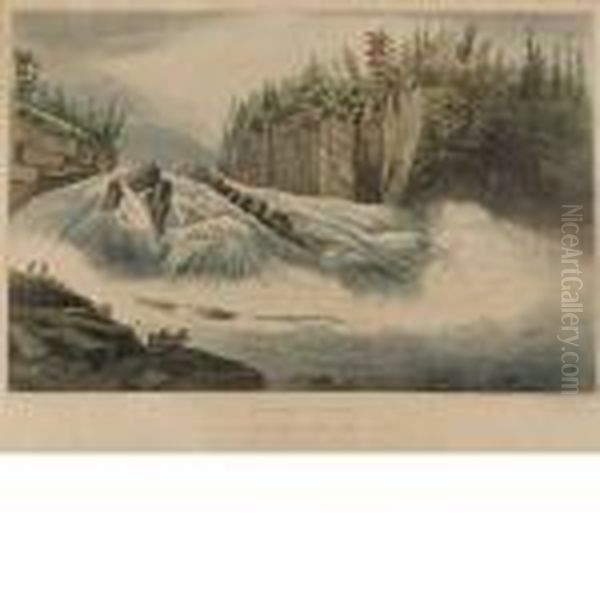
<em>Cauterskill Falls from the Cavern</em> (or Kaaterskill Falls): The Kaaterskill Falls in the Catskill Mountains were another iconic American landscape subject, famously painted by Thomas Cole. Wall's depiction, likely from the 1820s, would have contributed to the growing fame of this location. One version, exhibited in 1827, reportedly caused a sensation, though some critics found its depiction "too painful," perhaps indicating a more dramatic or emotionally charged rendering than some of his other, more placid views. This suggests Wall was capable of varying his approach depending on the subject.
<em>The Bay of New York and Governors Island taken from Brooklyn Heights</em>: This work would have showcased the expansive harbor, a vital center of commerce and activity. Views from Brooklyn Heights were prized for their panoramic scope, encompassing the tip of Manhattan, the surrounding islands, and the busy shipping lanes.
<em>Farm in the Valley, Troy, New York</em>: This title suggests a more pastoral scene, focusing on the cultivated landscape and the agrarian ideal that was still a strong part of the American identity. It would have represented a different facet of the American scene compared to the wilder views of the Hudson or the Catskills.
These works, whether as individual watercolors or as prints, helped to define the visual iconography of the American Northeast in the early 19th century. They provided a visual record of a landscape undergoing transformation and fostered a national appreciation for its unique beauty.
Role in Art Institutions and Community
William Guy Wall was not an isolated artist; he was an active participant in the burgeoning art community of New York. His most significant institutional affiliation was with the National Academy of Design (NAD). Founded in 1825 by a group of younger artists, including Samuel F.B. Morse, Asher B. Durand, and Thomas Cole, the NAD aimed to provide a more artist-run alternative to the existing American Academy of the Fine Arts.
Wall is recognized as one of the founding members of the National Academy of Design. This association underscores his standing among his peers and his commitment to advancing the cause of American art and artists. He regularly exhibited his works at the NAD's annual exhibitions, contributing to their success and helping to establish the institution as a central force in American art life. For instance, he exhibited works like View on the Helderberg Mountains at the NAD.

Beyond the NAD, Wall also exhibited at other prominent venues, such as the Pennsylvania Academy of the Fine Arts (PAFA) in Philadelphia and the Apollo Association in New York (which later became the American Art-Union). These exhibitions provided crucial platforms for artists to showcase their work, gain patronage, and engage with the public. Wall's consistent participation indicates his active professional life and his integration into the key artistic networks of the time.
His involvement in these institutions also suggests a desire to see American art flourish and to create supportive structures for artists. The founding of the NAD, in particular, was a statement of independence and ambition by American artists, and Wall was part of that pioneering generation.
Later Career, Moves, and Return to Ireland
After his initial successful decade in New York (roughly 1818-1828), William Guy Wall's life and career saw several relocations. Around 1828, he moved from New York City to Newport, Rhode Island, a town known for its scenic beauty and established social elite. He continued to paint, likely finding new subjects in the coastal landscapes of New England.
Subsequently, he resided in New Haven, Connecticut, another city with a rich history and picturesque surroundings. He also spent time in Brooklyn, which was then a separate city from New York, offering different perspectives of the harbor and Manhattan. During these years, he continued to work as a landscape painter. There is also a record of him creating background paintings for a popular silhouette artist and "profile painter" named Hubard, indicating a versatility in applying his artistic skills.
In 1835 or 1837 (sources vary slightly), after more than two decades in America, William Guy Wall made the decision to return to his native Ireland. He settled in Dublin, the city of his birth. The reasons for this move are not entirely clear but could have been related to family matters, a desire to reconnect with his roots, or perhaps shifting opportunities in the art world.
He continued his artistic career in Dublin, though perhaps with less prominence than he had achieved in America. The Irish art scene had its own dynamics, and the taste for landscape might have differed from that in the United States.
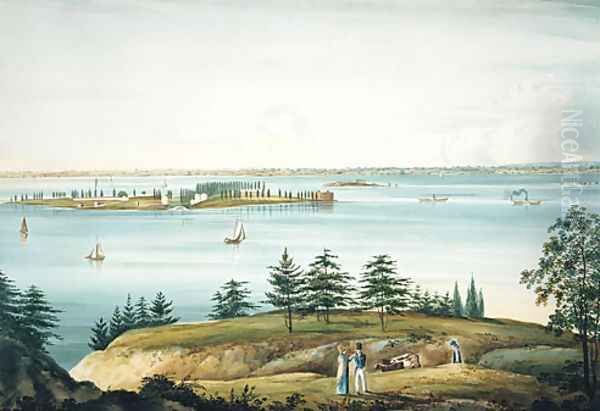
Interestingly, Wall did not remain in Ireland permanently for the rest of his life. He made at least one return trip to America, living and working there again from approximately 1856 to 1860. This later period in the United States is less documented than his earlier, formative years. By this time, the Hudson River School was in its full flower, with artists like Frederic Edwin Church and Albert Bierstadt creating monumental canvases of American and South American scenery. Wall's more restrained, topographical style might have seemed somewhat old-fashioned compared to these grander, more romantic visions.
After this final sojourn in America, Wall returned once more to Dublin. He passed away there in 1864, at the age of 72. His death occurred far from the landscapes that had defined his most influential work, but his legacy in American art was already firmly established.
Contemporaries and Artistic Milieu
William Guy Wall operated within a dynamic artistic milieu, both in America and, to a lesser extent, during his periods in Ireland. His most significant collaborator, as previously mentioned, was the engraver John Hill, and later Hill's son, John William Hill (1812-1879), who was himself a talented watercolorist associated with the Pre-Raphaelite movement in America.
In the context of early American landscape painting, Wall was a contemporary of Thomas Doughty (1793-1856), another pioneer of the Hudson River School, known for his lyrical and somewhat idealized landscapes. While Wall's work was generally more topographical, both artists contributed to the growing interest in American scenery.
The towering figures of the first generation of the Hudson River School, Thomas Cole (1801-1848) and Asher B. Durand (1796-1886), were also his contemporaries. Cole, with his allegorical and often dramatic landscapes, brought a different sensibility to the movement, while Durand, who outlived Wall, championed a more direct and naturalistic approach, famously advocating for painting directly from nature. Wall's Hudson River Portfolio predates much of Cole's most famous work and Durand's influential landscapes, positioning Wall as an important forerunner.
As a founding member of the National Academy of Design, Wall worked alongside artists like Samuel F.B. Morse (1791-1872), who, though more famous as an inventor, was a respected portrait painter and the NAD's first president. Other early NAD members included portraitists, genre painters, and architects, creating a diverse artistic community.
During his time in America, the art scene also included prominent portrait painters like Gilbert Stuart (1755-1828) and Thomas Sully (1783-1872), whose careers overlapped with Wall's. While their primary genre differed, they were part of the same developing American art world.
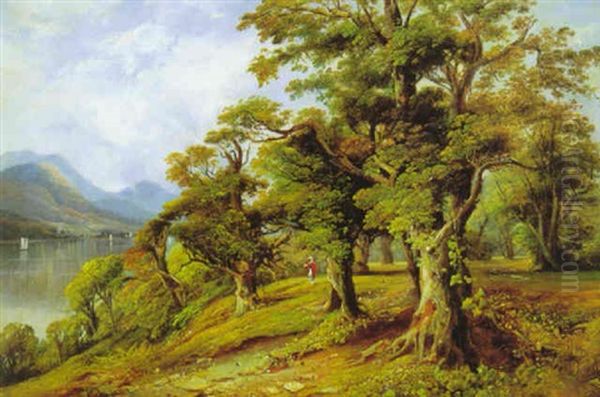
The influence of British watercolorists on Wall's style is evident. Artists like Paul Sandby (1731-1809), often called the "father of English watercolour," established traditions that Wall would have absorbed. The subsequent generation, including Thomas Girtin (1775-1802) and J.M.W. Turner (1775-1851), further elevated the medium, and their innovations would have been known to an artist like Wall.
Later Hudson River School artists, such as Frederic Edwin Church (1826-1900), Albert Bierstadt (1830-1902), Sanford Robinson Gifford (1823-1880), and Jasper Francis Cropsey (1823-1900), built upon the foundations laid by Wall and his contemporaries, expanding the geographical scope and often the scale and ambition of American landscape painting. Wall's earlier, more intimate views provided a crucial starting point for these later developments. His work, through prints, helped cultivate the audience that would later embrace these grander visions.
Art Historical Evaluation and Legacy
William Guy Wall's position in art history is primarily secured by his pioneering role in American landscape painting and his significant contribution to the early development of the Hudson River School. He is lauded for being among the first artists to systematically capture and popularize the scenery of the Hudson River Valley, a region that became central to America's artistic identity.
His Hudson River Portfolio, in collaboration with John Hill, is universally recognized as a landmark achievement. It not only provided a beautiful and enduring record of the Hudson's landscapes but also demonstrated the potential of American scenery as a subject for serious art. The portfolio's wide dissemination helped to foster a national appreciation for the American environment and set a high standard for topographical art in the country.
Art historians value Wall's direct, often unromanticized approach to landscape. His work is seen as an important bridge between the more formal, picturesque traditions of European landscape art and the emerging naturalism of the American school. He brought a sophisticated watercolor technique to the New World and adapted it effectively to depict the unique light and atmosphere of American locales.
While he may not have achieved the same level of fame as Thomas Cole or later Hudson River School masters, his foundational work was critical. He helped to "discover" and popularize many of the sites that would become iconic subjects for subsequent generations of painters. His role as a founding member of the National Academy of Design also highlights his importance within the artistic community of his time.
Some critical discussions might note that his style, while accomplished, did not always possess the emotional depth or philosophical ambition of artists like Cole. The comment about his Cauterskill Falls being "too painful" is an interesting footnote, suggesting that when he did attempt more dramatic effects, the reception could be mixed, perhaps because it deviated from the more placid and picturesque mode for which he was known.
His works are held in major American museum collections, including the Metropolitan Museum of Art, the New-York Historical Society, the Amon Carter Museum of American Art, and the Hudson River Museum, attesting to his enduring significance. Locally, institutions like the New Bedford Whaling Museum also value his contributions, particularly for works depicting their specific regions.
In recent decades, there has been a renewed appreciation for early American art and the foundational figures of movements like the Hudson River School. Wall's contributions, particularly his watercolors and the prints made from them, are increasingly recognized for their artistic merit and historical importance. He provided a visual language for a young nation eager to define itself through its landscape.
Conclusion: A Lasting Impression on American Art
William Guy Wall, the Irish immigrant who embraced the landscapes of his adopted American home, left an indelible mark on the art of the United States. His meticulous watercolors and the widely circulated prints from the Hudson River Portfolio were instrumental in shaping how Americans, and indeed the world, viewed the natural beauty of the Hudson River Valley and surrounding regions. He was a pioneer, venturing into the field of American landscape depiction at a time when it was still nascent, and laying a crucial foundation upon which the celebrated Hudson River School would build.
His direct and honest portrayal of nature, combined with a refined technical skill, captured the spirit of a young nation discovering its own scenic wonders. As a founding member of the National Academy of Design, he also played a role in fostering an environment where American art could thrive. Though his later career saw him move between continents, his most impactful years were those spent chronicling the American scene. William Guy Wall's legacy endures in his beautiful depictions of a landscape that continues to inspire, and in his recognized status as a key early figure in the story of American art.